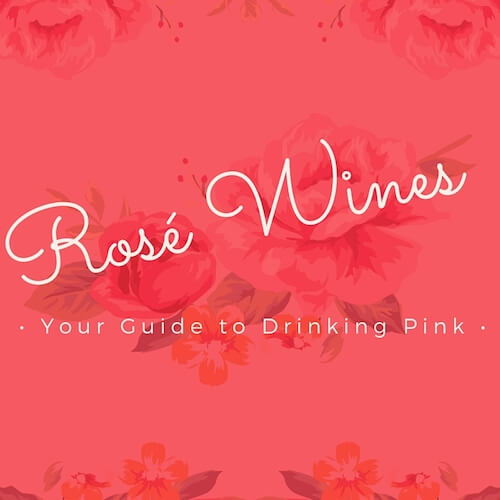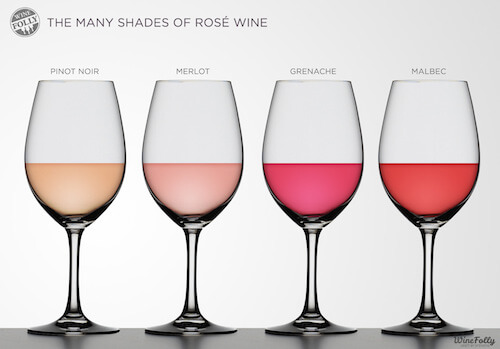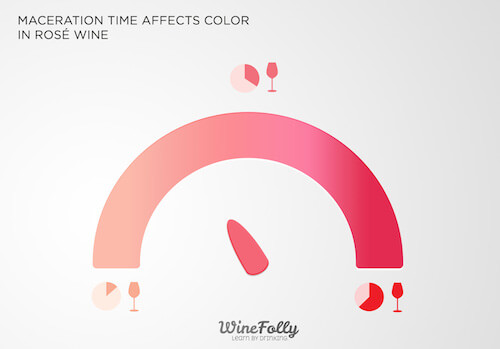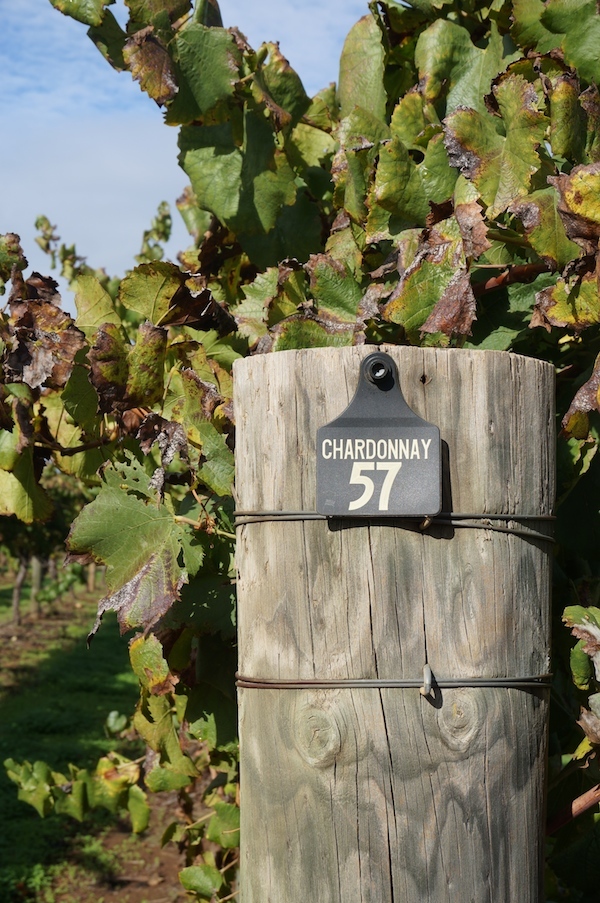Rosé Wine – Your Guide to Drinking Pink

I have to admit I’ve underestimated rosé wine in the past. Every now and then I’ll have a glass but it’s never been a serious wine in my books. It wasn’t until I started to drink more and more rosé and read up on it that I began to appreciate its versatility in the wine world. I became intrigued about how and why rosé came about; What is it? How is it made? What food goes with it? It’s these questions and more I hope to answer in this mini guide to rosé wines and drinking pink!
So let’s get stuck with in..
Table of contents
What is rosé?
It’s a wine style. It’s not made from a specific grape variety or from any specific wine region. Like red or white wine, it’s simply a category of wine. And a pretty one too coming in a range of ‘rosé’ shades.
Rosé can be still or sparkling, sweet or dry and you may even find it called ‘blush’ at some wineries.
Your international rosé guide (if you don’t have the bottle in front of you that is):
- Rosé in France & many other countries
- Rosado in Portugal & Spanish-speaking countries
- Rosato in Italy
Does rosé age?
With the exception of rosé champagnes and rosé from Bandol in France, typically rosé is made to be drunk young. Unlike its red wine sibling, rosé is adored because of its freshness and youthfulness.
As the wines aren’t in contact with the grape skins, seeds and stems for every long they don’t gain the preservative antioxidant components like red wines. And typically oak ageing isn’t used which is another technique to help preserve and extend a wines life in the bottle.
Sweet vs dry rosé
Myth buster alert!! Like Riesling, not all rosé wines are sweet!Click To TweetActually you’ll probably find more dry roses around these days because that’s what us wine drinkers want. We want fresh, acidic and balanced wines and winemakers are giving us that.
The tricky thing is sometimes at the bottle shop or in a restaurant there are no hints given as to where a wine sits on the dry-sweet scale. The best advice is to ask! Otherwise typically you’ll find Old World/European roses will be drier than New World wines. However this can backfire as it’s definitely not a solid rule, be warned!
What grapes are rosé wines made from?
Rosé wines can be made from a number of different grape varieties. They can be made from a single variety or a blend of 2-3 grapes varieties is also common.
Dry European roses traditionally have been made from Grenache, Sangiovese, Syrah, Mourvèdre, Carignan, Cinsault, and Pinot Noir.
In Australia and other places in the world you’ll find them made from the above but also from Merlot, Cabernet, Tempranillo and more!
And there are rose blends with white grapes in too, think rosé champagne which typically has Chardonnay in the blend. MyattsField Vineyards in the Perth Hills released a Sauvignon Blanc, Pinot Noir, Shiraz rosé last year as part of their Tête-à-Tête à Trois Rosé Challenge. Peter Yealands in New Zealand also makes a vibrant pink ‘Sauvignoir’ made of Sauvignon Blanc & Pinot Noir.
How is rosé wine made?
You may think rosé is as easy as getting a bottle of red wine, a bottle of white wine and mixing these together (I’ve seen a lot of people do this at parties actually, thinking they are pretty awesome). However it’s not exactly that simple, especially if you’re after quality. There are 3 common ways to make rosé wines:
- Skin contact
- Blending
- Saignée
Skin contact is the most common method used when a winemaker specifically sets out to make a rosé wine. This involves lightly crushing red grapes so the juice and grape skins macerate (soak) – imparting colour from the skins to the juice. Depending on the depth of colour and flavours the winemaker wants to achieve, the maceration can take anywhere from a couple of hours to a few days. After which the grape skins and solids (known as must in wine-geek speak) are removed and the strained liquid moves into the fermentation stage. For a red wine the maceration stage takes a lot longer, typically a number of weeks.
Saignée or ‘bleeding’ in English refers to when a winemaker sets out to make a red wine but also might make a rosé wine on the side. If a winemaker wants to impart more colour and flavour into a red wine during maceration they might remove or ‘bleed off’ some of the pink juice early on. The juice left is more concentrated for the red wine desired and the bonus by-product is the removed juice can then be fermented separately to make a rosé! That’s some good multi-tasking!
Blending as you’d presume is basically just the mixing of a red and white wine. This is discouraged in a lot of parts of the world. It’s actually forbidden throughout France except for in Champagne (yet most producers use the saignée method anyway).
There are a few other techniques like Vin Gris and Decolorisation that can be used however these aren’t used to the same extent as the above rosé methods.
When is International Rosé Day?
There are about 4 different rosé days on the annual wine days calendar:
- The 4th Friday in June every year was started in 2018 by Valérie Rousselle, owner of Châteaux Roubine and Sainte Béatrice in Provence, France
- The second Saturday in June every year was started by Bodvár House of Rosés in 2015
- August 14th was started by the blog Wine Geeks in 2005 as a National Rosé Day for America I believe.
- And February 5th was started as National Rosé Day in New Zealand which @Fraserinwine and I decided in 2021 that this should include Australia too!
Hey at the end of the day, I don’t mind having four extra excuses to drink rosé during the year 😉
What is a Southern France/Provence style rosé?
Firstly if you get a chance to visit the South of France, I’d highly recommend visiting the Languedoc wine country. In the rosé world you’ll know doubt come across a Southern France rosé at some point or you’ll come across a rosé from somewhere else in the world where the winemaker will describe it as a Southern France style rosé.
Basically Provence is known for its elegant and lean dry roses. They’re characterised as fresh, crisp, bright, dry and food friendly wines. You’ll hear a lot of strawberry, raspberry and citrus flavours thrown around when talking about these wines.
Provençal wines are only allowed to be made from red grape varieties by law (Grenache is a popular choice). As mentioned above the skins stay in contact with the juice for a small amount of time to impart that beautiful shade of rosé we see in our glass. Provençal roses are distinctively light in colour (a pale pink or salmon colour).
Check out this Wine Folly post describing 10 different rosé styles to learn more about how they can differ so much.
What food should you match with rosé wines?
It’s that in between wine, it’s not white nor red but it’s something in the middle – and this works to its advantage. With fuller and lighter styles of rosé you can easily match these with both richer and lighter dishes.
Naturally Mediterranean dishes are a match made in heaven with the Southern France style roses but also Asian-inspired dishes, Indian cuisine, tapas, BBQ and tex-mex work well too. Actually it’s probably the easiest wine to match as it goes pretty well with most things from sweet to savoury! It’s just finding that right one in amongst all the bottles.
Why do people ignore rosé?
Like most things it comes in and out of style.
Just because it’s pink doesn’t mean it’s a ladies drink and I think we’d probably all agree this connotation is not really an issue anyway. I mean look at the pink shirt phenomenon.
There are some haters out there for the pink drink as they may have had a bad experience with an overly sweet version or a low quality cheaply made one. But as long as you stay clear of the rosé goon, then you’ll know doubt fall in love with the style again, just like me.
What about frosé?
I say hell yes to frosé! Why the heck not? I know there are some wine snobs out there who think it’s defamatory for rosé wine – but who cares. It’s just a bit of fun and is rather delicious too! Mr. Spittoon and I actually had a ‘frosé-off’ recently and came up with what I think is one of the best and easiest frosé recipes out there!
So there you have it guys, a mini guide to rosé wine and why you should probably give it some TLC for your next wine drinking session!



